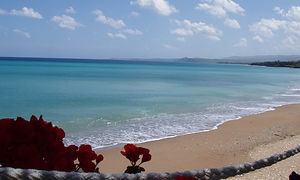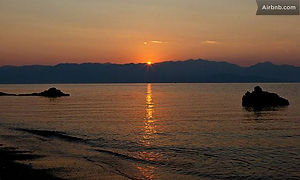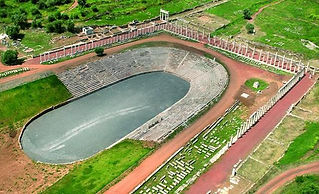
Chrani Official
Website
Messinia Greece
Πολυλίμνιο
Στη περιοχή της Χαραυγής, 23χμ από τους Χράνους και 35 από την Καλαμάτα, σε ένα απερίγραπτου κάλλους φυσικό τοπίο βρίσκεται το σύμπλεγμα λιμνών που ονομάστηκε Πολυλίμνιο. Οι λίμνες καλά κρυμμένες για πολλά χρόνια, μόλις πρόσφατα έγιναν ευρύτερα γνωστές και άρχισαν να δέχονται τις επισκέψεις όσων αγαπούν τις διαδρομές μέσα στη φύση.
Δεν έχετε λοιπόν παρά να αναζητήσετε και εσείς τις λίμνες με τα παράξενα ονόματα, όπως τη Μαυρόλιμνα, τη λίμνη του Τυχερού, της Σταθούλας, την Καδουλα και τις υπόλοιπες και να απολαύσετε το ονειρικό τοπίο που συνθέτουν. Τα μικρά φαράγγια, η πλούσια βλάστηση και οι πανέμορφοι καταρράκτες θα μετατρέψουν μια μέσης δυσκολίας πεζοπορία σε μια εμπειρία μοναδική και αξέχαστη .
Η λιμνοθάλασσας της Γιάλοβας
Η λιμνοθάλασσα Γιάλοβα, Πύλου αποτελεί το νοτιότερο υγρότοπο διεθνούς σημασίας των Βαλκανίων (Grimmet, R.& Jones T. 1989) αφού είναι ένας πολύ σημαντικός σταθμός για χιλιάδες πουλιά που χρησιμοποιούν τη διαδρομή της Δυτικής Ελλάδας κατά τη μετανάστευση.
Το κάστρο της Κορώνης
Στο νότιο τμήμα της Κορώνης ορθώνεται το κάστρο της. Στους κλασικούς χρόνους αποτελούσε μία απλή οχύρωση, για να γίνει αργότερα Βυζαντινό φρούριο, το οποίο κατέλαβαν το 1205 οι Φράγκοι(Γάλλοι) της Δ' Σταυροφορίας.
Σήμερα το Κάστρο είναι ερειπωμένο, ενώ διατηρούνται το παλαιοημερολογίτικο γυναικείο μοναστήρι του Τιμίου Ιωάννη του Προδρόμου, ο ερειπωμένος βυζαντινός ναός της Αγίας Σοφίας, η εκκλησία του Αγ. Χαραλάμπους και το «ΡΕΣΑΛΤΟ» χώρος ιστορικής μνήμης όπου εκεί έπεσαν οι Έλληνες αγωνιστές οι οποίοι προσπάθησαν το 1824 να καταλάβουν το Κάστρο.
Σώζονται επίσης λαξευμένοι τάφοι, βενετσιάνικες στέρνες, τούρκικο χαμάμ και οι περίφημοι «θόλοι».
Σε κάθε γωνιά του κάστρου υπάρχει και μία «θόλος» δηλαδή. μπαρουταποθήκη ή μπιζιχανές, ενώ η καλύτερη «θόλος» ανατινάχτηκε από Γερμανούς το 1944 κατά την αποχώρηση τους..
Το κάστρο της Μεθώνης
Το κάστρο της Μεθώνης βρίσκεται στο νοτιότατο άκρο της δυτικής ακτής της Πελοποννήσου σε θέση που οχυρώνεται από τον 7 π.Χ αιώνα. Έως το 1204 μ.Χ χρησιμοποιείται ως φρούριο των Βυζαντινών, ενώ το 1209 μ.Χ οι Ενετοί με την συνθήκη της Σαπιέντζας (1209) γίνονται κυρίαρχοι της περιοχής και καθιστούν τη Μεθώνη οικονομικό κέντρο και εμπορικό λιμάνι, οπότε το κάστρο γνωρίζει μεγάλη ανάπτυξη, οχυρώνεται και οικοδομείται με τη βενετσιάνικη αρχιτεκτονική. Το 1500 μ.Χ καταλαμβάνεται από τους Τούρκους του Βαγιαζήτ Β΄ οπότε η περιοχή και το κάστρο οδηγούνται σε παρακμή.
Αρχαία Μεσσήνη (Ιθώμη)
Η Μεσσήνη υπήρξε μία από τις σημαντικότερες πόλεις της αρχαιότητας και βρίσκεται κτισμένη στο νοτιοδυτικό τμήμα της Πελοποννήσου, στους πρόποδες του όρους Ιθώμη. Ιδρύθηκε το 370 π.Χ. από το στρατηγό Επαμεινώνδα, μετά τη νίκη του εναντίον των Σπαρτιατών, με σκοπό να κατοικήσουν εκεί οι απελευθερωμένοι Μεσσήνιοι. Μέχρι τα τέλη του 4ου μ.Χ. αιώνα, η Μεσσήνη ήταν το πολιτιστικό κέντρο του νομού. Δεν είναι τυχαίο ότι εκεί βρίσκεται το φημισμένο Αρχαίο Θέατρο της Μεσσήνης, το οποίο σήμερα φιλοξενεί πολιτιστικές εκδηλώσεις.
Sightseeing - Αξιοθέατα


Polylimnio (lakes and waterfalls)
In the village of Charavgi (20 minutes drive from Paris Village), hidden in an environment of absolute charm, the visitor can explore the lakes of Polylimnio (which means "many lakes"). Fifteen small lakes with strange names such us Mavrolimna (black lake), Kadoula (small basin), Tycheros (lucky), were well hidden for centuries and it is only since recently that they become accessible to the public. They all form a wild but beautiful environment with small canyons, and enchanting waterfalls. Visiting them is not just a simple walk, but also an exciting meeting with the nature that will be well established in the thoughts and memories of those following their "watery ways".
You can drive to Charavgi with your car, which you can leave in the parking place, just before the beginning of the path that leads to the lakes. There is a small picnic area but no facilities, so you better take with you water and anything else you think you might need. However, try not to carry too many supplies because the trail is of middle difficulty and you should wear flat shoes and comfortable clothes.
The Divari Lagoon (also known as the Pylos or Gialova Lagoon) is place of exceptional beauty with big historical and cultural heritage, a place with priceless natural value. The lagoon of Gialova belongs to the European network NATURE 2000 and is one of the most important bands for the birds of Greece. It is the more southern migratory turning point of the Balkans for birds. From the 255 types of birds that until now have been observed, the 79 are protected according to directive 79/409/EOK. Up to now 16 ecotypes, 34 species of reptiles, 28 species of mammals and 16 species of fishes have been recorded.
The Castle Of Koroni in Messinia
The castle of Koroni is erected in the south part of the city of Koroni Messinia. In the classical years it was a simple, plain fort but it later became a byzantine fort, which was conquered by the Franks (the French) of the 4th crusade in 1205.
The Castle & Fortress of Methoni
The castle of Methoni is at the southernmost point of the west coast of the Peloponnese in a place which had been fortified since the 7th century B.C. Until 1204 A.D. it was used as a fort for the Byzantines while in 1209 A.D. the Eneti, acccording to the treaty of Sapientza, they become the lords of the area and establish Methoni as a financial centre and a commercial port when the castle meets with great development, is fortified and is built according to Venetian architecture.
Ancient Messinia (Ithomi)
From Chrani you have the chance to visit two of the most inportant archaiological monuments in Greece. Ancient Messene (Messini) or Ithomi is a significant ancient city in terms of its size, form, and state of preservation, and still has much to offer. It possesses not only sanctuaries and public buildings, but also imposing fortifications, and houses and tombs. It enjoys, amongst other things, the advantage of never having been destroyed or covered by later settlements, and is located on an unspoiled inland site. Its natural setting combines the grandeur of the mountains of Delphi with the low-lying, riverine tranquillity of Olympia, the dominating bare limestone mass of Ithome, the site of the ancient acropolis, with the low fertile valley around the ancient city.

